Exogenous Applications of Bio-fabricated Silver Nanoparticles to Improve Biochemical, Antioxidant, Fatty Acid and Secondary Metabolite Contents of Sunflower
Abstract
:1. Introduction
2. Materials and Methods
2.1. Biogenesis of AgNPs by Using Aqueous Extract of Euphorbia Helioscopia
2.2. Morphological and Optical Characterization of AgNPs
2.3. Treatment of Sunflower Seeds with AgNPs
2.4. Agro-Morphological Evaluation of Plants Treated with AgNPs
2.5. Antioxidant Enzymatic Activity Measurement of the Plants Treated with AgNPs
2.5.1. Superoxide Dismutase (SOD) Assay
2.5.2. Ascorbate Peroxidase (APx) Assay
2.6. Biochemical Parameters of the Plants Treated with AgNPs
2.6.1. Determination of the Chlorophyll Contents
2.6.2. Determination of Proline Contents
2.6.3. Determination of Soluble Sugar Contents
2.6.4. Determination of Free Amino Acid Contents
2.6.5. Determination of Total Protein Contents
2.7. Determination of the Oil Content and Fatty Acid Composition of the Plants Treated with AgNPs
2.8. Data Analysis
3. Results and Discussion
3.1. Phyto-Synthesis of AgNPs
3.2. Physical and Optical Characterization of AgNPs
3.3. Agro-Morphological Parameter of Sunflower Plants Treated with AgNPs
3.4. Antioxidant Enzymatic Potential of the Sunflower Plants Treated with AgNPs
3.5. Biochemical Parameter of the Sunflower Plants Treated with AgNPs
3.5.1. Chlorophyll Contents
3.5.2. Proline Content
3.5.3. Soluble Sugar Contents
3.5.4. Protein and Amino Acid Contents
3.6. Seed Quality Parameter and Fatty Acid Profiling of Sunflower Plants After the Applications of AgNPs
4. Conclusions
Author Contributions
Funding
Data Availability Statement
Acknowledgments
Conflicts of Interest
Ethics Approval
References
- Satti, S.H.; Raja, N.I.; Javed, B.; Akram, A.; Mashwani, Z.-R.; Ahmad, M.S.; Ikram, M. Titanium dioxide nanoparticles elicited agro-morphological and physicochemical modifications in wheat plants to control Bipolaris sorokiniana. PLoS ONE 2021, 16, e0246880. [Google Scholar] [CrossRef] [PubMed]
- Ahmed, F.; Javed, B.; Razzaq, A.; Mashwani, Z.U.R. Applications of copper and silver nanoparticles on wheat plants to induce drought tolerance and increase yield. IET Nanobiotechnol. 2021, 15, 68–78. [Google Scholar] [CrossRef]
- Ikram, M.; Raja, N.I.; Javed, B.; Mashwani, Z.-R.; Hussain, M.; Hussain, M.; Ehsan, M.; Rafique, N.; Malik, K.; Sultana, T.; et al. Foliar applications of bio-fabricated selenium nanoparticles to improve the growth of wheat plants under drought stress. Green Process. Synth. 2020, 9, 706–714. [Google Scholar] [CrossRef]
- Duhan, J.S.; Kumar, R.; Kumar, N.; Kaur, P.; Nehra, K.; Duhan, S. Nanotechnology: The new perspective in precision agriculture. Biotechnol. Rep. 2017, 15, 11–23. [Google Scholar] [CrossRef]
- Ram, P.; Vivek, K.; Kumar, S.P. Nanotechnology in sustainable agriculture: Present concerns and future aspects. Afr. J. Biotechnol. 2014, 13, 705–713. [Google Scholar] [CrossRef] [Green Version]
- Almutairi, Z.M.; Alharbi, A. Effect of Silver Nanoparticles on Seed Germination of Crop Plants. J. Adv. Agric. 2015, 10, 283–288. [Google Scholar] [CrossRef]
- Yaseen, A.; Wasan, M. Response of Sunflower (Helianthus annuus L.) to Spraying of Nano Silver, Organic Fertilizer (Algastar) and Salicylic Acid and Their Impact on Seeds Content of Fatty Acids and Vicine. Am. J. Exp. Agric. 2015, 9, 1–12. [Google Scholar] [CrossRef]
- Javed, B.; Ikram, M.; Farooq, F.; Sultana, T.; Mashwani, Z.-R.; Raja, N.I. Biogenesis of silver nanoparticles to treat cancer, diabetes, and microbial infections: A mechanistic overview. Appl. Microbiol. Biotechnol. 2021, 150, 2261–2275. [Google Scholar] [CrossRef]
- Ikram, M.; Javed, B.; Raja, N.I.; Mashwani, Z.-R. Biomedical Potential of Plant-Based Selenium Nanoparticles: A Comprehensive Review on Therapeutic and Mechanistic Aspects. Int. J. Nanomed. 2021, 16, 249–268. [Google Scholar] [CrossRef]
- Javed, B.; Raja, N.I.; Nadhman, A.; Mashwani, Z.-R. Understanding the potential of bio-fabricated non-oxidative silver nanoparticles to eradicate Leishmania and plant bacterial pathogens. Appl. Nanosci. 2020, 10, 2057–2067. [Google Scholar] [CrossRef]
- Pérez-Vich, B.; Velasco, L.; Fernández-Martínez, J.M. Determination of seed oil content and fatty acid composition in sunflower through the analysis of intact seeds, husked seeds, meal and oil by near-infrared reflectance spectroscopy. J. Am. Oil Chem. Soc. 1998, 75, 547–555. [Google Scholar] [CrossRef]
- Cantagallo, J.E.; Hall, A.J. Reduction in the number of filled seed in sunflower (Helianthus annuus) by light stress. In Proceedings of the 15th International Sunflower Conference, Tolouse, France, 15 June 2000. [Google Scholar]
- Grunvald, A.K.; de Carvalho, C.G.P.; Santos Leite, R.; Gontijo Mandarino, J.M.; Andrade, C.A.; Alberto Scapim, C. Predicting the oil contents in sunflower genotype seeds using near- infrared reflectance (NIR) spectroscopy. Acta Sci. Agron. 2014, 36, 233–237. [Google Scholar] [CrossRef] [Green Version]
- Binkoski, A.E.; Kris-Etherton, P.M.; Wilson, T.A.; Mountain, M.L.; Nicolosi, R.J. Balance of unsaturated fatty acids is important to a cholesterol-lowering diet: Comparison of mid-oleic sunflower oil and olive oil on cardiovascular disease risk factors. J. Am. Diet. Assoc. 2005, 105, 1080–1086. [Google Scholar] [CrossRef]
- Bahadori, M.B.; Zengin, G.; Bahadori, S.; Dinparast, L.; Movahhedin, N. Phenolic composition and functional properties of wild mint (Mentha longifolia var. calliantha (Stapf) Briq.). Int. J. Food Prop. 2018, 21, 198–208. [Google Scholar] [CrossRef] [Green Version]
- Santhoshkumar, T.; Rahuman, A.A.; Jayaseelan, C.; Rajakumar, G.; Marimuthu, S.; Kirthi, A.V.; Velayutham, K.; Thomas, J.; Venkatesan, J.; Kim, S.-K. Green synthesis of titanium dioxide nanoparticles using Psidium guajava extract and its antibacterial and antioxidant properties. Asian Pac. J. Trop. Med. 2014, 7, 968–976. [Google Scholar] [CrossRef] [Green Version]
- Alam, H.; Khatoon, N.; Raza, M.; Ghosh, P.C.; Sardar, M. Synthesis and Characterization of Nano Selenium Using Plant Biomolecules and Their Potential Applications. Bionanoscience 2019, 9, 96–104. [Google Scholar] [CrossRef]
- Nounou, M.I.; Elamrawy, F.; Ahmed, N.; Abdelraouf, K.; Goda, S.; Syed-Sha-Qhattal, H. Breast cancer: Conventional diagnosis and treatment modalities and recent patents and technologies supplementary issue: Targeted therapies in breast cancer treatment. Breast Cancer Basic Clin. Res. 2015, 9, 17–34. [Google Scholar] [CrossRef] [Green Version]
- Shukla, P.; Chaurasia, P.; Younis, K.; Qadri, O.S.; Faridi, S.A.; Srivastava, G. Nanotechnology in sustainable agriculture: Studies from seed priming to post-harvest management. Nanotechnol. Environ. Eng. 2019, 4, 11. [Google Scholar] [CrossRef]
- Fraceto, L.F.; Grillo, R.; de Medeiros, G.A.; Scognamiglio, V.; Rea, G.; Bartolucci, C. Nanotechnology in agriculture: Which innovation potential does it have? Front. Environ. Sci. 2016, 4, 20. [Google Scholar] [CrossRef]
- Javed, B.; Nadhman, A.; Mashwani, Z.U.R. Phytosynthesis of Ag nanoparticles from Mentha longifolia: Their structural evaluation and therapeutic potential against HCT116 colon cancer, Leishmanial and bacterial cells. Appl. Nanosci. 2020. [Google Scholar] [CrossRef]
- Javed, B.; Nadhman, A.; Razzaq, A.; Mashwani, Z. One-pot phytosynthesis of nano-silver from Mentha longifolia L.: Their characterization and evaluation of photodynamic potential. Mater. Res. Express 2020, 7, 055401. [Google Scholar] [CrossRef]
- Javed, B.; Mashwani, Z.U.R. Phytosynthesis of colloidal nanosilver from Mentha longifolia and Mentha arvensis: Comparative morphological and optical characterization. Microsc. Res. Tech. 2020, 83, 1299–1307. [Google Scholar] [CrossRef]
- Javed, B.; Nadhman, A.; Mashwani, Z. Optimization, characterization and antimicrobial activity of silver nanoparticles against plant bacterial pathogens phyto-synthesized by Mentha longifolia. Mater. Res. Express 2020, 7, 085406. [Google Scholar] [CrossRef]
- Harrach, B.D.; Fodor, J.; Pogány, M.; Preuss, J.; Barna, B. Antioxidant, ethylene and membrane leakage responses to powdery mildew infection of near-isogenic barley lines with various types of resistance. Eur. J. Plant Pathol. 2008, 121, 21–33. [Google Scholar] [CrossRef]
- Hoang, S.A.; Nguyen, L.Q.; Nguyen, N.H.; Tran, C.Q.; Nguyen, D.V.; Vu, Q.N.; Phan, C.M. Metal nanoparticles as effective promotors for Maize production. Sci. Rep. 2019, 9, 13925. [Google Scholar] [CrossRef] [PubMed] [Green Version]
- Sarwer, A.; Javed, B.; Soto, E.B.; Mashwani, Z. Impact of the COVID-19 pandemic on maternal health services in Pakistan. Int. J. Health Plann. Manag. 2020, 35, 1306–1310. [Google Scholar] [CrossRef]
- Monreal, J.A.; Jiménez, E.T.; Remesal, E.; Morillo-Velarde, R.; García-Mauriño, S.; Echevarría, C. Proline content of sugar beet storage roots: Response to water deficit and nitrogen fertilization at field conditions. Environ. Exp. Bot. 2007, 60, 257–267. [Google Scholar] [CrossRef]
- Rehman, A.; Rehman, S.; Khatoon, A.; Qasim, M.; Itoh, T.; Iwasaki, Y.; Wang, X.; Sunohara, Y.; Matsumoto, H.; Komatsu, S. Proteomic analysis of the promotive effect of plant-derived smoke on plant growth of chickpea. J. Proteom. 2018, 176, 56–70. [Google Scholar] [CrossRef]
- Azooz, M.M.; Abou-elhamd, M.F.; Al-fredan, M.A. Biphasic effect of copper on growth, proline, lipid peroxidation and antioxidant enzyme activities of wheat ( Triticum aestivum cv. Hasaawi) at early growing stage. Aust. J. Crop Sci. 2012, 6, 688–694. [Google Scholar]
- Javed, B.; Mashwani, Z.-R. Synergistic Effects of Physicochemical Parameters on Bio-Fabrication of Mint Silver Nanoparticles: Structural Evaluation and Action against HCT116 Colon Cancer Cells. Int. J. Nanomed. 2020, 15, 3621–3637. [Google Scholar] [CrossRef]
- Javed, B.; Mashwani, Z.; Sarwer, A.; Raja, N.I.; Nadhman, A. Synergistic response of physicochemical reaction parameters on biogenesis of silver nanoparticles and their action against colon cancer and leishmanial cells. Artif. Cells Nanomed. Biotechnol. 2020, 48, 1340–1353. [Google Scholar] [CrossRef]
- Beddoes, C.M.; Case, C.P.; Briscoe, W.H. Understanding nanoparticle cellular entry: A physicochemical perspective. Adv. Colloid. Interface Sci. 2015, 218, 48–68. [Google Scholar] [CrossRef] [PubMed]
- Ruthardt, N.; Lamb, D.C.; Bräuchle, C. Single-particle tracking as a quantitative microscopy-based approach to unravel cell entry mechanisms of viruses and pharmaceutical nanoparticles. Mol. Ther. 2011, 19, 1199–1211. [Google Scholar] [CrossRef] [PubMed]
- Karami Mehrian, S.; De Lima, R. Nanoparticles cyto and genotoxicity in plants: Mechanisms and abnormalities. Environ. Nanotechnol. Monit. Manag. 2016, 6, 184–193. [Google Scholar] [CrossRef]
- Das, P.; Barua, S.; Sarkar, S.; Karak, N.; Bhattacharyya, P.; Raza, N.; Kim, K.H.; Bhattacharya, S.S. Plant extract–mediated green silver nanoparticles: Efficacy as soil conditioner and plant growth promoter. J. Hazard. Mater. 2018, 346, 62–72. [Google Scholar] [CrossRef]
- Verma, S.K.; Das, A.K.; Patel, M.K.; Shah, A.; Kumar, V.; Gantait, S. Engineered nanomaterials for plant growth and development: A perspective analysis. Sci. Total Environ. 2018, 630, 1413–1435. [Google Scholar] [CrossRef]
- Raliya, R.; Tarafdar, J.C. Biosynthesis and characterization of zinc, magnesium and titanium nanoparticles: An eco-friendly approach. Int. Nano Lett. 2014, 4, 93. [Google Scholar] [CrossRef] [Green Version]
- Monica, R.C.; Cremonini, R. Nanoparticles and higher plants. Caryologia 2009, 62, 161–165. [Google Scholar] [CrossRef] [Green Version]
- Carrillo-López, L.M.; Morgado-González, A.; Morgado-González, A. Biosynthesized Silver Nanoparticles Used in Preservative Solutions for Chrysanthemum cv. Puma. J. Nanomater. 2016, 2016, 1769250. [Google Scholar] [CrossRef] [Green Version]
- Khalil, I.; Yehye, W.A.; Etxeberria, A.E.; Alhadi, A.A.; Dezfooli, S.M.; Julkapli, N.B.M.; Basirun, W.J.; Seyfoddin, A. Nanoantioxidants: Recent trends in antioxidant delivery applications. Antioxidants 2020, 9, 24. [Google Scholar] [CrossRef] [Green Version]
- Caverzan, A.; Casassola, A.; Brammer, S.P. Antioxidant responses of wheat plants under stress. Genet. Mol. Biol. 2016, 39, 1–6. [Google Scholar] [CrossRef] [Green Version]
- Zia, M.; Yaqoob, K.; Mannan, A.; Nisa, S.; Raza, G.; ur Rehman, R. Regeneration response of carnation cultivars in response of silver nanoparticles under in vitro conditions. Vegetos 2019, 33, 11–20. [Google Scholar] [CrossRef]
- Noori, A.; Donnelly, T.; Colbert, J.; Cai, W.; Newman, L.A.; White, J.C. Exposure of tomato (Lycopersicon esculentum) to silver nanoparticles and silver nitrate: Physiological and molecular response. Int. J. Phytoremediation 2019, 22, 40–51. [Google Scholar] [CrossRef] [PubMed]
- Gupta, S.D.; Agarwal, A.; Pradhan, S. Phytostimulatory effect of silver nanoparticles (AgNPs) on rice seedling growth: An insight from antioxidative enzyme activities and gene expression patterns. Ecotoxicol. Environ. Saf. 2018, 161, 624–633. [Google Scholar] [CrossRef]
- Ali, S.; Rizwan, M.; Hussain, A.; Zia ur Rehman, M.; Ali, B.; Yousaf, B.; Wijaya, L.; Alyemeni, M.N.; Ahmad, P. Silicon nanoparticles enhanced the growth and reduced the cadmium accumulation in grains of wheat (Triticum aestivum L.). Plant Physiol. Biochem. 2019, 140, 1–8. [Google Scholar] [CrossRef] [PubMed]
- Sharma, P.; Bhatt, D.; Zaidi, M.G.H.; Saradhi, P.P.; Khanna, P.K.; Arora, S. Silver nanoparticle-mediated enhancement in growth and Antioxidant Status of Brassica juncea. Appl. Biochem. Biotechnol. 2012, 167, 2225–2233. [Google Scholar] [CrossRef]
- Kastori, R.; Plesničar, M.; Sakač, Z.; Panković, D.; Arsenijević-Maksimović, I. Effect of excess lead on sunflower growth and photosynthesis. J. Plant Nutr. 1998, 21, 75–85. [Google Scholar] [CrossRef]
- Droppa, M.; Horváth, G. The role of copper in photosynthesis The Role of Copper in Photosynthesis. Plant Sci. 2008, 37–41. [Google Scholar] [CrossRef]
- Rodríguez-González, V.; Obregón, S.; Patrón-Soberano, O.A.; Terashima, C.; Fujishima, A. An approach to the photocatalytic mechanism in the TiO2-nanomaterials microorganism interface for the control of infectious processes. Appl. Catal. B Environ. 2020, 270, 118853. [Google Scholar] [CrossRef]
- Scandalios, J.G. Oxidative stress: Molecular perception and transduction of signals. Braz. J. Med. Biol. Res. 2005, 38, 995–1014. [Google Scholar] [CrossRef]
- Mittler, R. Oxidative stress, antioxidants and stress tolerance. Trends Plant Sci. 2002, 7, 405–410. [Google Scholar] [CrossRef]
- Huerta-García, E.; Pérez-Arizti, J.A.; Márquez-Ramírez, S.G.; Delgado-Buenrostro, N.L.; Chirino, Y.I.; Iglesias, G.G.; López-Marure, R. Titanium dioxide nanoparticles induce strong oxidative stress and mitochondrial damage in glial cells. Free Radic. Biol. Med. 2014, 73, 84–94. [Google Scholar] [CrossRef] [PubMed]
- Mohamed, A.K.S.H.; Qayyum, M.F.; Mustafa, A.; Rehman, R.A.; Ali, S.; Rizwan, M. Interactive effect of salinity and silver nanoparticles on photosynthetic and biochemical parameters of wheat. Arch. Agron. Soil Sci. 2017, 63, 1736–1747. [Google Scholar] [CrossRef]
- Mehmood, A.; Murtaza, G. Impact of biosynthesized silver nanoparticles on protein and carbohydrate contents in seeds of pisum sativum L. Crop Breed. Appl. Biotechnol. 2017, 17, 334–340. [Google Scholar] [CrossRef] [Green Version]
- Karami Mehrian, S.; Heidari, R.; Rahmani, F. Effect of silver nanoparticles on free amino acids content and antioxidant defense system of tomato plants. Indian J. Plant Physiol. 2015, 20, 257–263. [Google Scholar] [CrossRef]
- Gole, A.; Dash, C.; Ramakrishnan, V.; Sainkar, S.R.; Mandale, A.B.; Rao, M.; Sastry, M. Pepsin-gold colloid conjugates: Preparation, characterization, and enzymatic activity. Langmuir 2001, 17, 1674–1679. [Google Scholar] [CrossRef]
- Vannini, C.; Domingo, G.; Onelli, E.; Prinsi, B.; Marsoni, M.; Espen, L.; Bracale, M. Morphological and Proteomic Responses of Eruca sativa Exposed to Silver Nanoparticles or Silver Nitrate. PLoS ONE 2013, 8, e068752. [Google Scholar] [CrossRef] [Green Version]
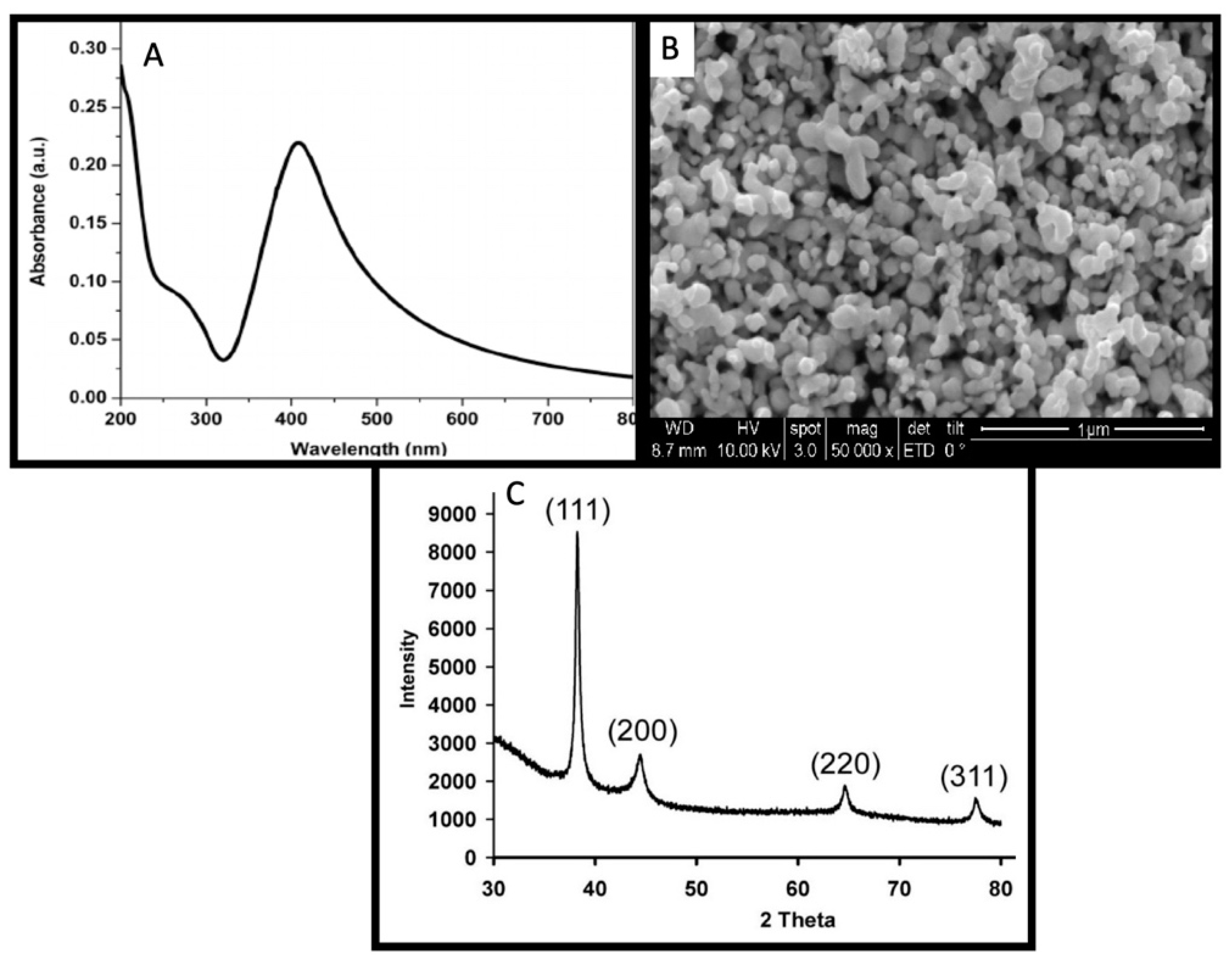
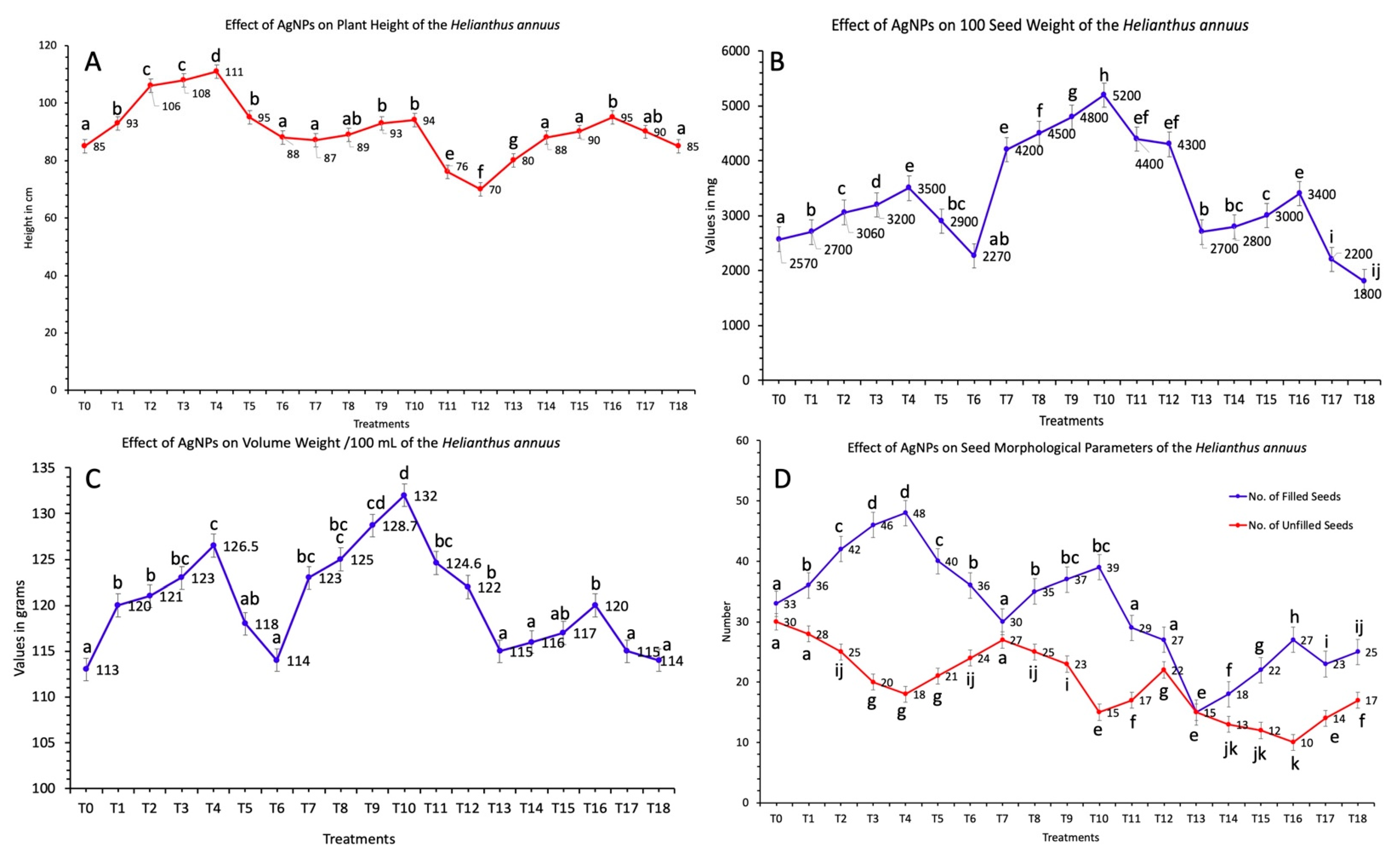
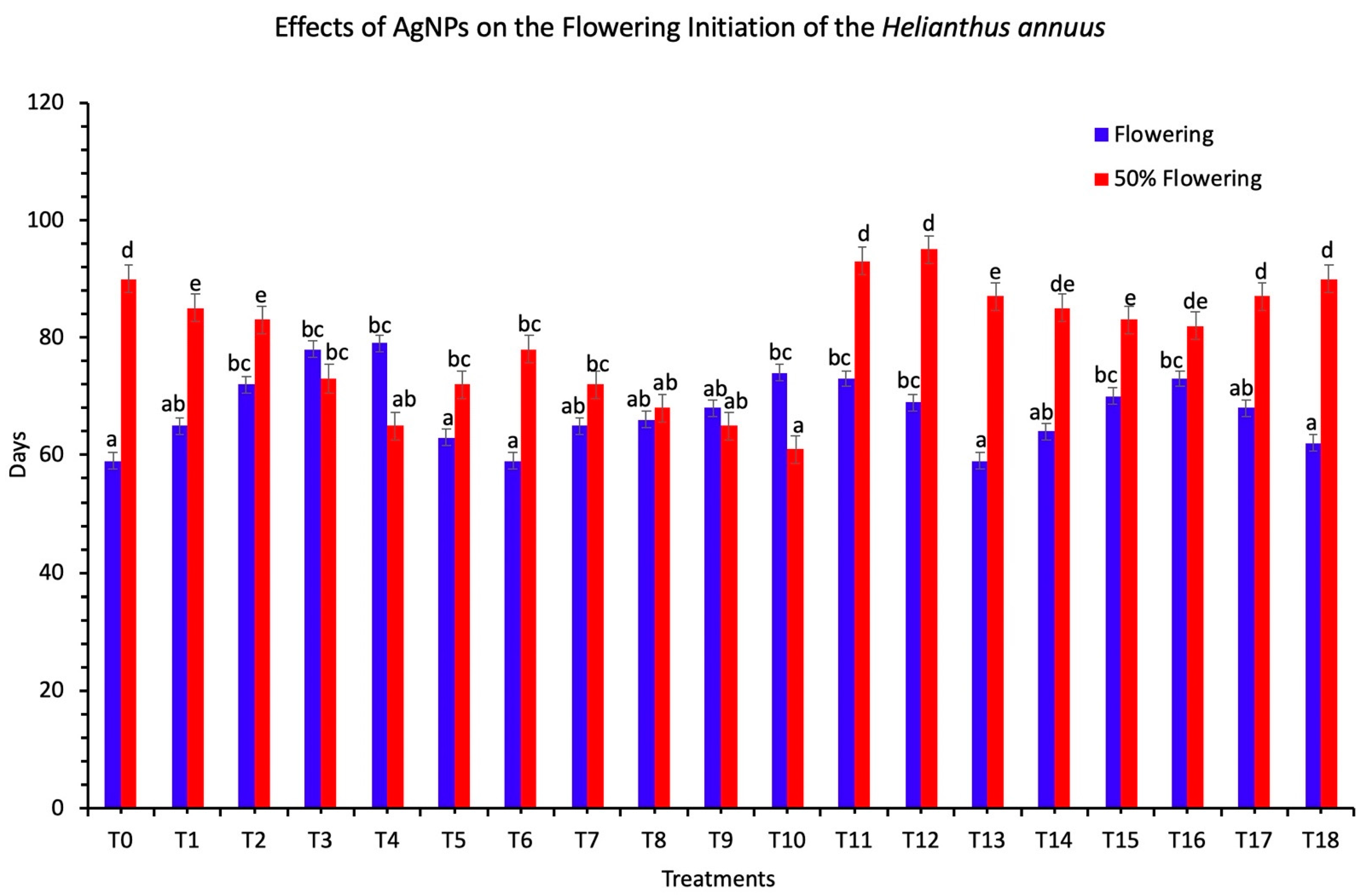
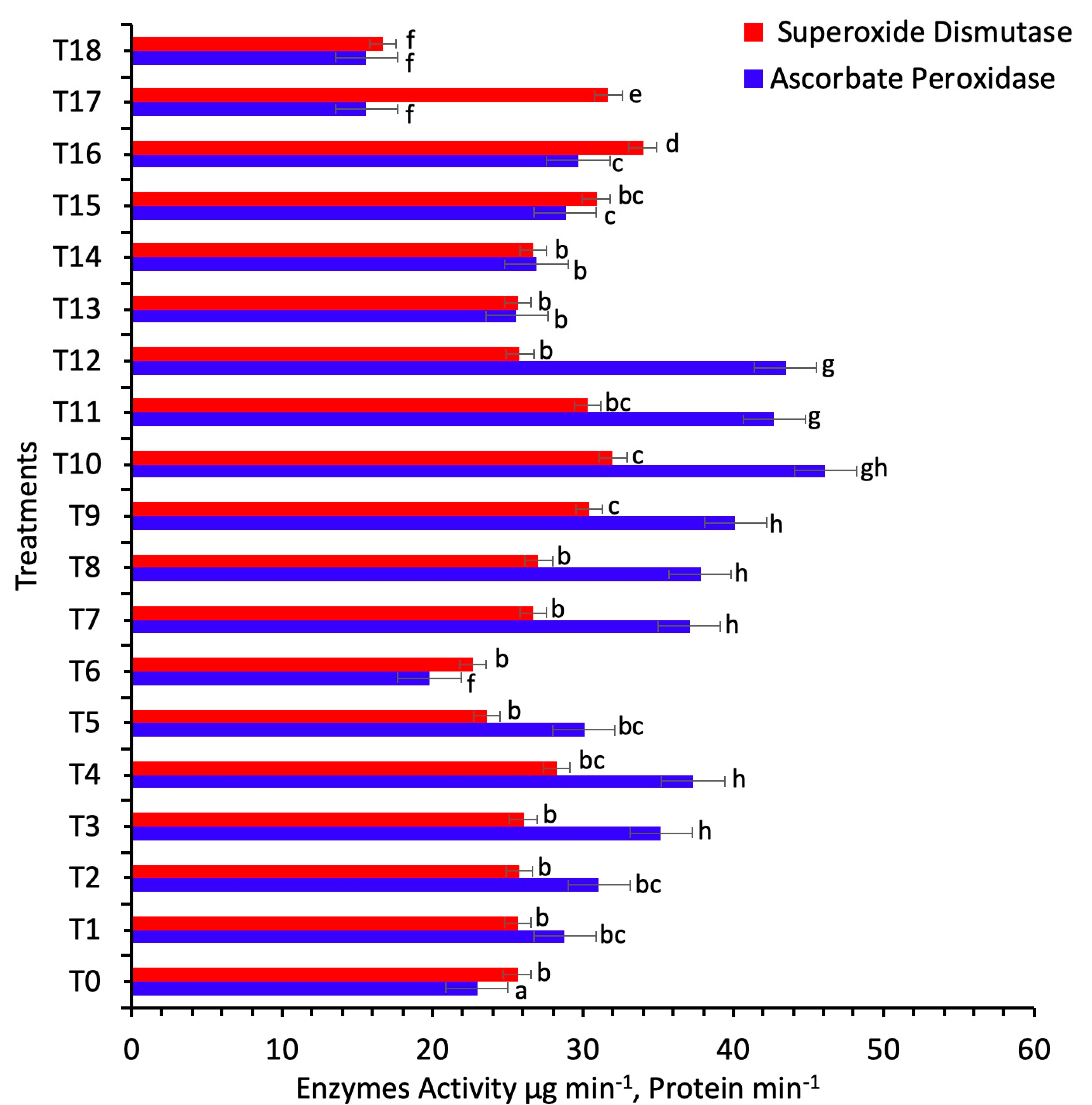
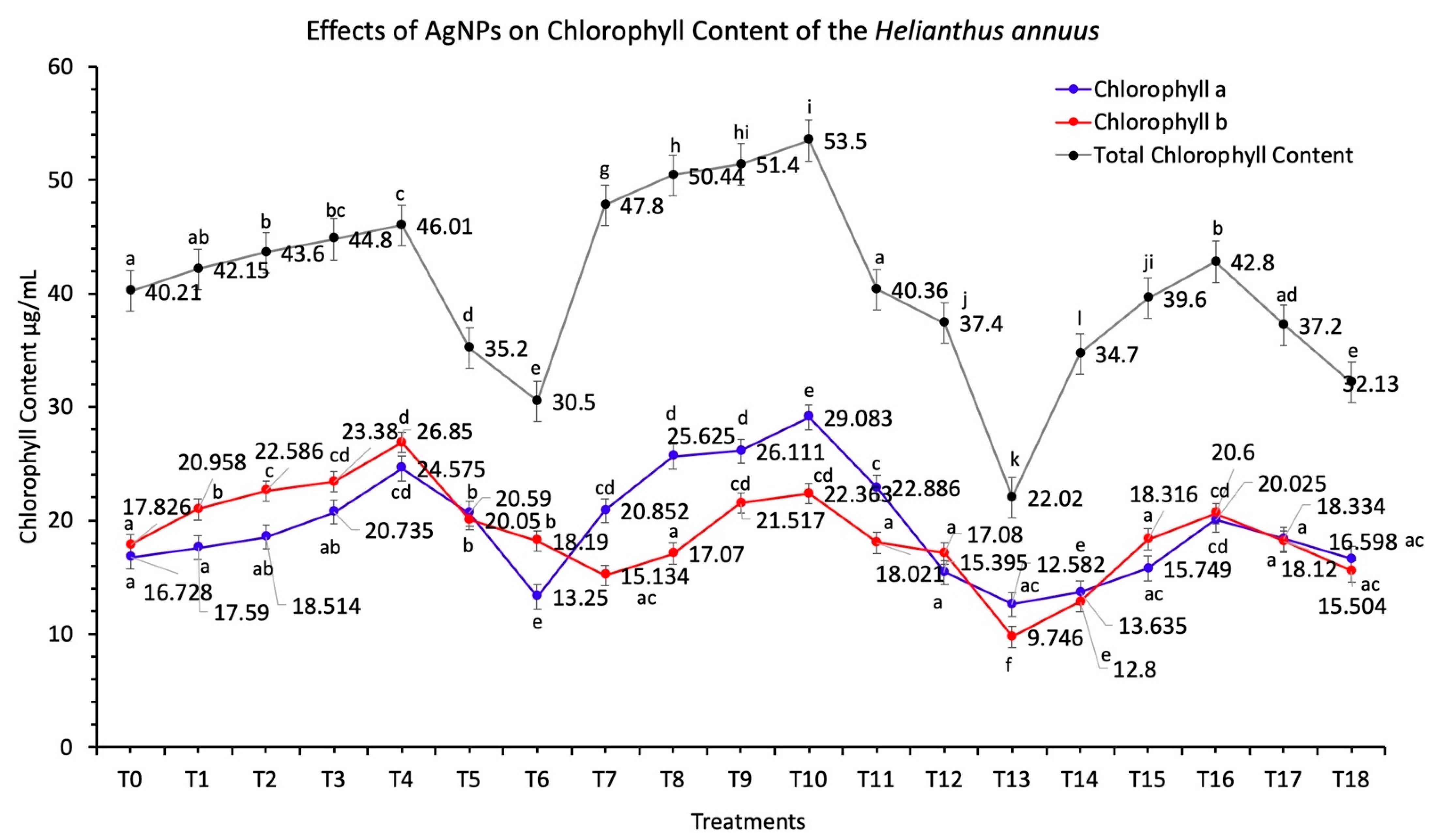
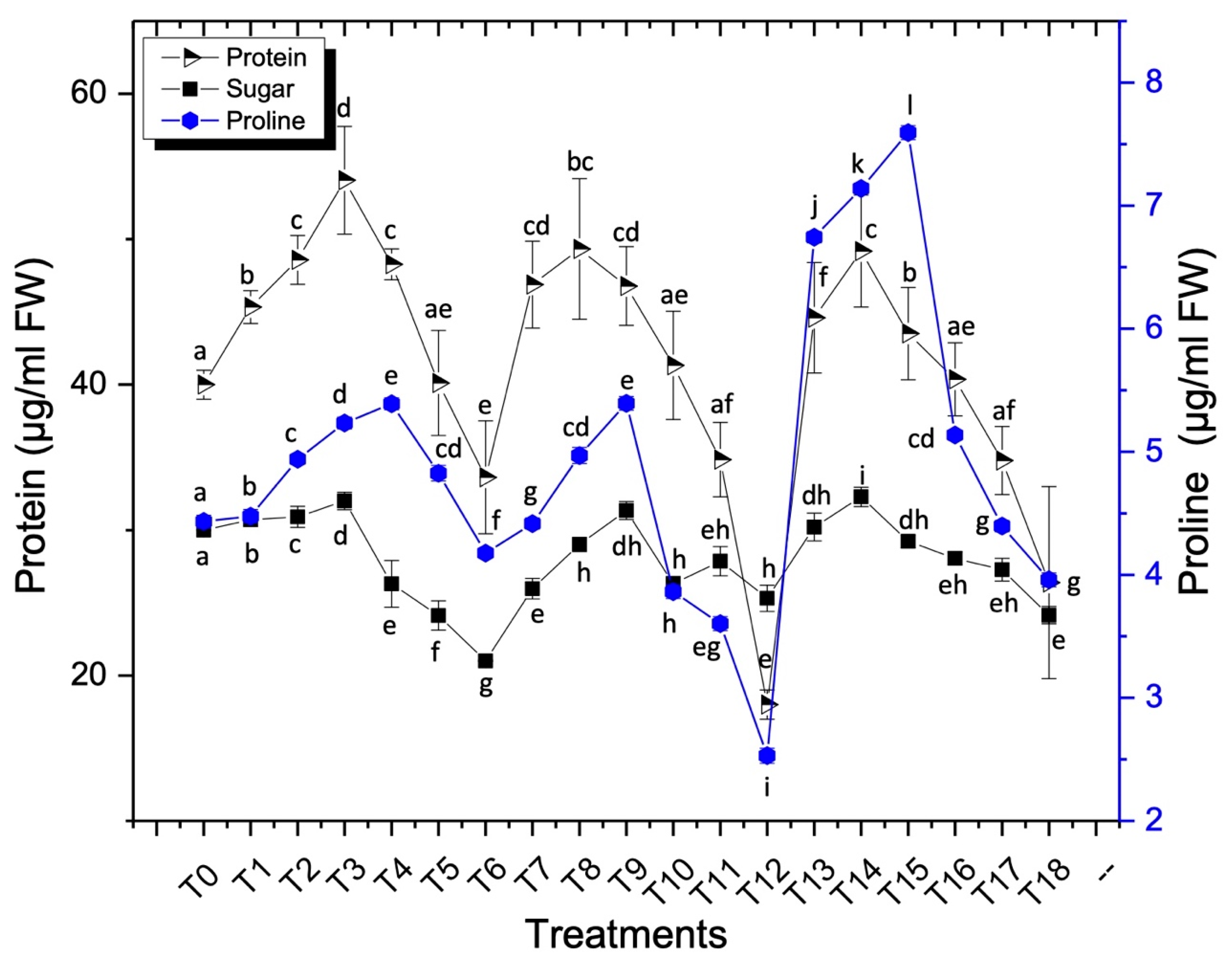
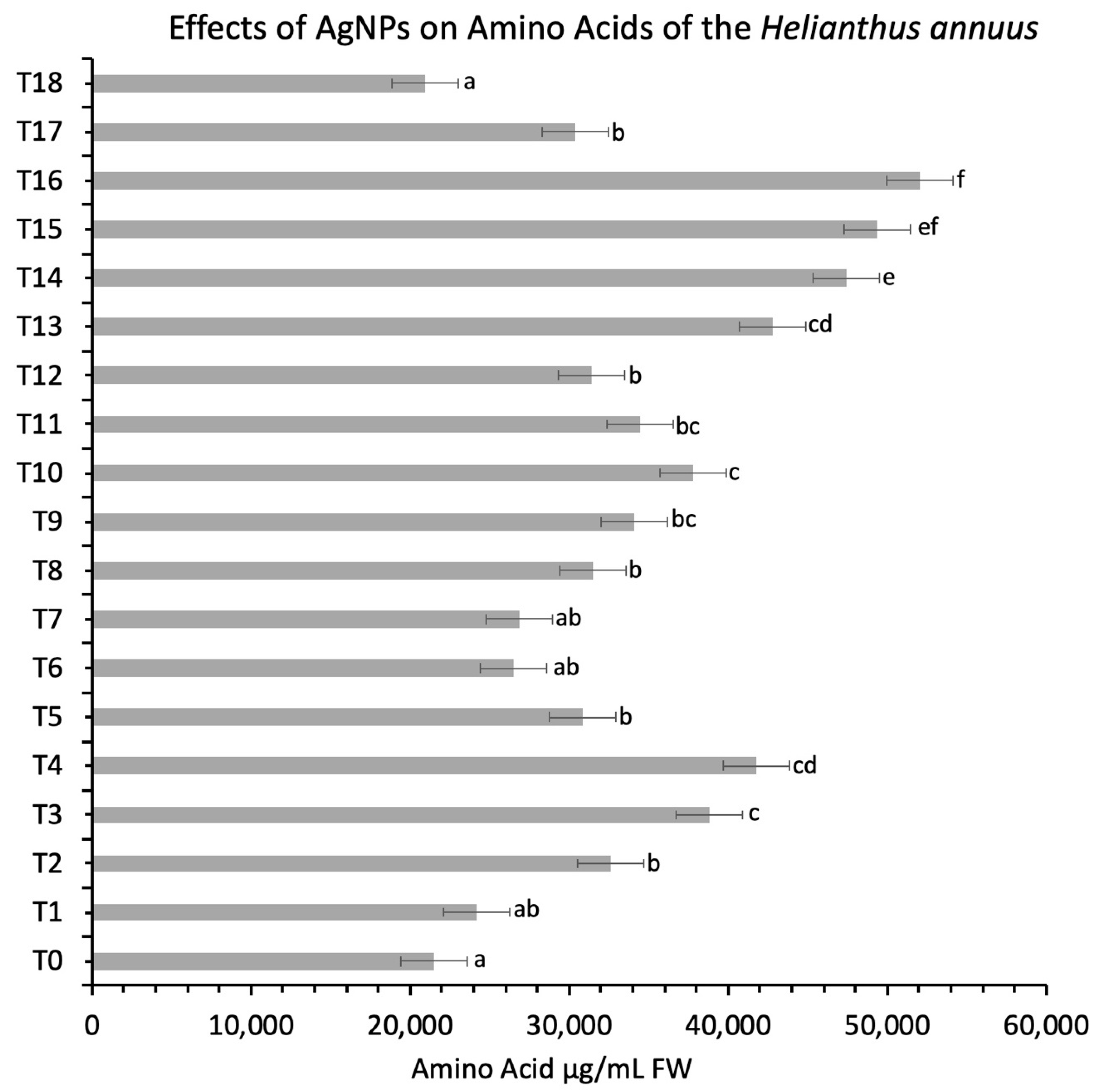
| Treatment | Treatment Description | Concentration |
|---|---|---|
| T0 | Control | 0 mg/L |
| T1 | Seed treated | 10 mg/L |
| T2 | Seed treated | 20 mg/L |
| T3 | Seed treated | 40 mg/L |
| T4 | Seed treated | 60 mg/L |
| T5 | Seed treated | 80 mg/L |
| T6 | Seed treated | 100 mg/L |
| T7 | Seed treated + Foliar spray | 10 mg/L |
| T8 | Seed treated + Foliar spray | 20 mg/L |
| T9 | Seed treated + Foliar spray | 40 mg/L |
| T10 | Seed treated + Foliar spray | 60 mg/L |
| T11 | Seed treated + Foliar spray | 80 mg/L |
| T12 | Seed treated + Foliar spray | 100 mg/L |
| T13 | Foliar spray | 10 mg/L |
| T14 | Foliar spray | 20 mg/L |
| T15 | Foliar spray | 40 mg/L |
| T16 | Foliar spray | 60 mg/L |
| T17 | Foliar spray | 80 mg/L |
| T18 | Foliar spray | 100 mg/L |
| Treatments | Seed Quality Parameter | ||||
|---|---|---|---|---|---|
| Oil Content % | Palmitic Acid % | Stearic Acid % | Oleic Acid % | Linolenic Acid % | |
| T0 | 0.54 d | 6.6 a | 4 b | 28.56 e | 58.53 c |
| T1 | 0.56 d | 6.1 a | 3.97 ab | 28.9 e | 58.53 c |
| T2 | 0.59 cd | 5.93 b | 3.82 ab | 29.12 cd | 59.23 d |
| T3 | 0.66 a | 5.9 b | 3 a | 29.25 cd | 59.8 d |
| T4 | 0.61 c | 5.98 b | 3.6 d | 29 a | 59.2 d |
| T5 | 0.57 cd | 6.01 a | 3.97 ab | 28.7 e | 58.86 c |
| T6 | 0.52 cd | 6.38 a | 4.2 b | 28.43 e | 58.37 c |
| T7 | 0.48 e | 4.7 bc | 3.73 cd | 29.02 a | 58.56 c |
| T8 | 0.54 cd | 4.65 bc | 3.7 cd | 29.03 a | 58.37 c |
| T9 | 0.58 cd | 4.5 c | 3.62 c | 29.4 a | 57.56 b |
| T10 | 0.59 cd | 4.72 bc | 3.75 cd | 29.1 a | 57.48 b |
| T11 | 0.56 d | 4.82 bc | 3.79 cd | 29.8 cd | 57.4 b |
| T12 | 0.5 d | 4.97 bc | 3.84 d | 29.76 cd | 57.3 b |
| T13 | 0.49 e | 4.77 bc | 3.8 d | 29.53 cd | 57.15 a |
| T14 | 0.54 d | 4.71 bc | 3.72 cd | 29.01 a | 56.94 ab |
| T15 | 0.58 cd | 4.64 bc | 3.67 c | 28.72 e | 56.74 a |
| T16 | 0.65 b | 4.56 d | 3.61 c | 28.64 e | 56.7 a |
| T17 | 0.61 c | 4.67 bc | 3.68 c | 28.55 e | 56.6 a |
| T18 | 0.57 cd | 4.75 bc | 3.73 cd | 28.61 e | 56.53 a |
Publisher’s Note: MDPI stays neutral with regard to jurisdictional claims in published maps and institutional affiliations. |
© 2021 by the authors. Licensee MDPI, Basel, Switzerland. This article is an open access article distributed under the terms and conditions of the Creative Commons Attribution (CC BY) license (https://creativecommons.org/licenses/by/4.0/).
Share and Cite
Batool, S.U.; Javed, B.; Sohail; Zehra, S.S.; Mashwani, Z.-u.-R.; Raja, N.I.; Khan, T.; ALHaithloul, H.A.S.; Alghanem, S.M.; Al-Mushhin, A.A.M.; et al. Exogenous Applications of Bio-fabricated Silver Nanoparticles to Improve Biochemical, Antioxidant, Fatty Acid and Secondary Metabolite Contents of Sunflower. Nanomaterials 2021, 11, 1750. https://doi.org/10.3390/nano11071750
Batool SU, Javed B, Sohail, Zehra SS, Mashwani Z-u-R, Raja NI, Khan T, ALHaithloul HAS, Alghanem SM, Al-Mushhin AAM, et al. Exogenous Applications of Bio-fabricated Silver Nanoparticles to Improve Biochemical, Antioxidant, Fatty Acid and Secondary Metabolite Contents of Sunflower. Nanomaterials. 2021; 11(7):1750. https://doi.org/10.3390/nano11071750
Chicago/Turabian StyleBatool, Syeda Umber, Bilal Javed, Sohail, Syeda Sadaf Zehra, Zia-ur-Rehman Mashwani, Naveed Iqbal Raja, Tariq Khan, Haifa Abdulaziz Sakit ALHaithloul, Suliman Mohammed Alghanem, Amina A. M. Al-Mushhin, and et al. 2021. "Exogenous Applications of Bio-fabricated Silver Nanoparticles to Improve Biochemical, Antioxidant, Fatty Acid and Secondary Metabolite Contents of Sunflower" Nanomaterials 11, no. 7: 1750. https://doi.org/10.3390/nano11071750
APA StyleBatool, S. U., Javed, B., Sohail, Zehra, S. S., Mashwani, Z.-u.-R., Raja, N. I., Khan, T., ALHaithloul, H. A. S., Alghanem, S. M., Al-Mushhin, A. A. M., Hashem, M., & Alamri, S. (2021). Exogenous Applications of Bio-fabricated Silver Nanoparticles to Improve Biochemical, Antioxidant, Fatty Acid and Secondary Metabolite Contents of Sunflower. Nanomaterials, 11(7), 1750. https://doi.org/10.3390/nano11071750







